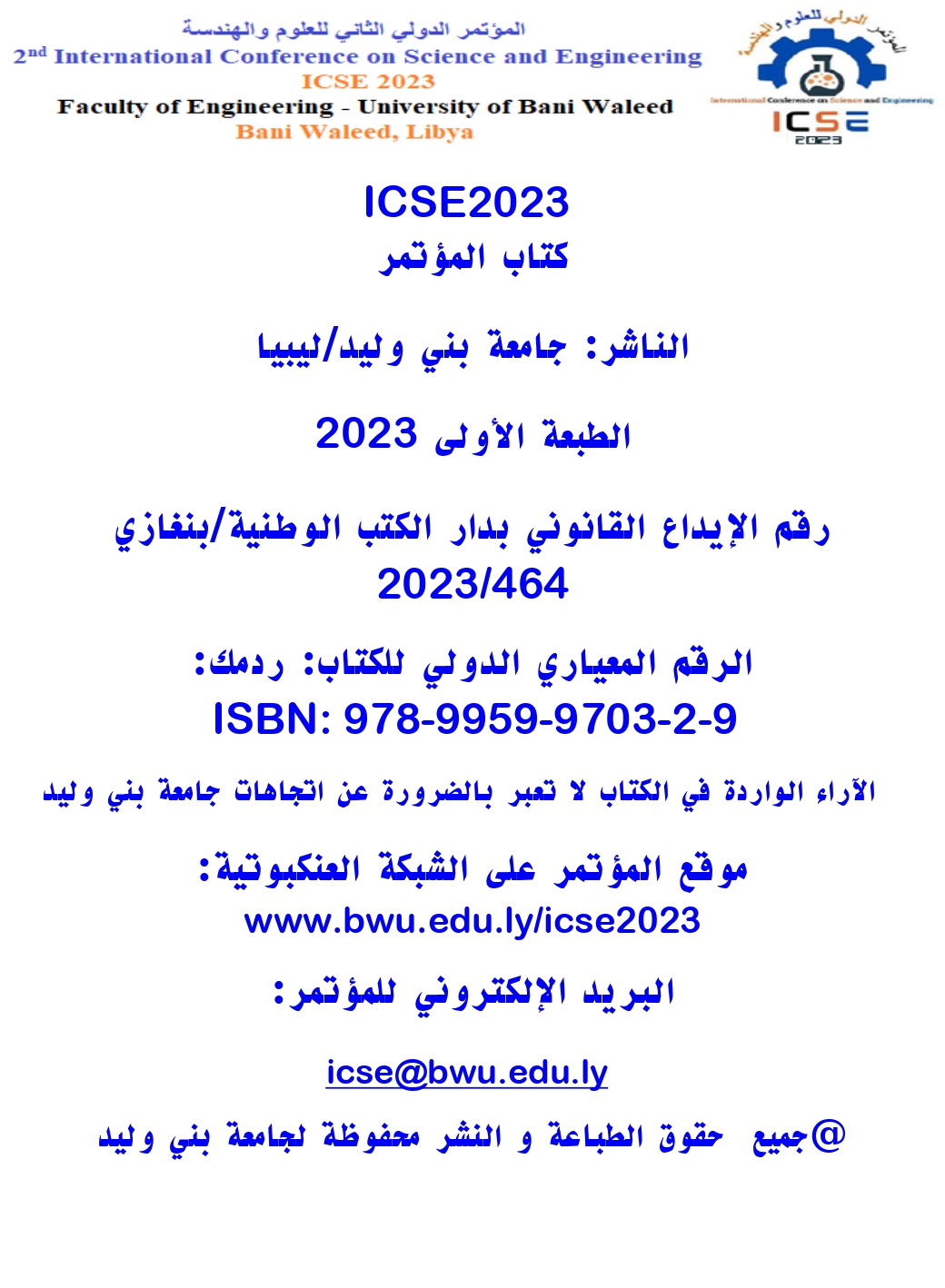Performance evaluation of eco-friendly mortar made with natural and artificial pozzolans; red clay and glass powder.
DOI:
https://doi.org/10.58916/jhas.v8i3.174Keywords:
Mortar, pozzolanic materials, red clay, glass powderAbstract
Abstract: To reduce the environmental impact associated with Portland cement (PC) manufacturing, the use of supplementary cementitious (pozzolanic materials) materials in the development of cement-based materials such as concrete and mortar, has gained great attention in recent years. For this reason, this research study investigates the effect of using two types of pozzolanic material (natural and industrial pozzolan), represented by red clay (RC) and glass powder (GP), as a partial substitution for Portland cement in the preparation of cement-based mortar. The methodology of this study involved the design of seven mortar mix compositions and evaluating them in terms of workability and unconfined compression strength (UCS). Accordingly, the results showed that the addition of glass powder as a cement substitution yielded a gradual workability improvement, whereas the incorporation of red clay as a cement substitution induces a gradual workability reduction. In contrast, the unconfined compression strength revealed that the optimum glass powder content for strength performance was 5%, whereas no strength improvement was observed in this study using red clay, thus indicating the superiority of glass powder in enhancing the mechanical properties of mortar. Therefore, the outcome of this study suggests the possibility of improving both the fresh and hardened mortar properties using glass powder, as a partial replacement for cement.
Downloads
References
Abdalla, T.A., Koteng, D.O., Shitote, S.M., and Matallah, M., (2022), Mechanical and durability properties of concrete incorporating silica fume and a high volume of sugarcane bagasse ash., Results in Engineering., 16, 100666. DOI: 10.1016/j.rineng.2022.100666.
Adeleke, B.O., Kinuthia, J.M., Oti, J., and Ebailila, M., (2023), Physico-mechanical evaluation of geopolymer concrete activated by sodium hydroxide and silica fume-synthesised sodium silicate solution., Materials., 16(6), 2400. DOI: 10.3390/ma16062400.
Nukah, P.D., Abbey, S.J., Booth, C.A., and Oti, J., (2022), Evaluation of the structural performance of low carbon concrete., Sustainability., 14(24), 16765. DOI: 10.3390/su142416765.
Samad, S., Shah, A., and Limbachiya, M.C., (2017), Strength development characteristics of concrete produced with blended cement using ground granulated blast furnace slag (GGBS) under various curing conditions., Sadhana - Academy Proceedings in Engineering Sciences., 42, 1203-121342. DOI: 10.1007/s12046-017-0667-z.
Oti, J.E., Kinuthia, J.M., and Bai, J., (2009), Compressive strength and microstructural analysis of unfired clay masonry bricks., Engineering Geology., 109(3-4), 230-240. DOI: 10.1016/j.enggeo.2009.08.010.
Dave, N., Misra, A.K., Srivastava, A., and Kaushik, S.K., (2016), Experimental analysis of strength and durability properties of quaternary cement binder and mortar., Construction and Building Materials., 107, 117-124. DOI: 10.1016/j.conbuildmat.2015.12.195.
Yan, X., Jiang, L., Guo, M., Chen, Y., Song, Z., and Bian, R., (2019), Evaluation of sulfate resistance of slag contained concrete under steam curing., Construction and Building Materials., 195, 231-237. DOI: 10.1016/j.conbuildmat.2018.11.073.
Ogawa, S., Nozaki, T., Yamada, K., Hirao, H., and Hooton, R.D., (2012), Improvement on sulfate resistance of blended cement with high alumina slag., Cement and Concrete Research, 42(2), 244-251. DOI: 10.1016/j.cemconres.2011.09.008.
Ebailila, M., Kinuthia, J., Oti, J., and Al-Waked, Q., (2022), Sulfate soil stabilisation with binary blends of lime–silica fume and lime–ground granulated blast furnace slag., Transportation Geotechnics., 37, 100888. DOI: 10.1016/j.trgeo.2022.100888.
Ebailila, M., Kinuthia, J., and Oti, J., (2022), Suppression of Sulfate-Induced Expansion with Lime–Silica Fume Blends., Materials., 15, 2821. DOI: 10.3390/ma15082821.
Mehta, A., and Ashish, D.K., (2020), Silica fume and waste glass in cement concrete production: A review., Journal of Building Engineering., 29, 100888. DOI: 10.1016/j.jobe.2019.100888.
Johari, M.M., Brooks, J.J., Kabir, S., and Rivard, P., (2011), Influence of supplementary cementitious materials on engineering properties of high strength concrete., Construction and Building Materials., 25, 2639-2648. DOI: 10.1016/j.conbuildmat.2010.12.013.
Cercel, J., Adesina, A. and Das, S., (2021), Performance of eco-friendly mortars made with alkali-activated slag and glass powder as a binder., Construction and Building Materials, 270, 121457.
Hwang, S.S. and Cortes, C.M.M., 2021. Properties of mortar and pervious concrete with co-utilization of coal fly ash and waste glass powder as partial cement replacements. Construction and Building Materials, 270, 121415.
Nahi, S., Leklou, N., Khelidj, A., Oudjit, M.N. and Zenati, A., (2020), Properties of cement pastes and mortars containing recycled green glass powder. Construction and Building Materials., 262, 120875.
BS EN 12620:2002+A1:2008, Aggregates for concrete, BSI Standards Limited, London, UK, 2008. https://doi.org/10.3403/02661981.
BS EN 206:2013+A2:2021, Concrete — Specification, performance, production and conformity., BSI Standards Limited, London, UK, 2021. https://doi.org/10.3403/30257890.
BS EN 12350-1:2019, Testing fresh concrete—Part 1: Sampling and common apparatus, BSI Standards Limited, London, UK, 2019. https://doi.org/10.3403/30360061.
BS EN 12390-1: 2021, Testing hardened concrete—Part 1: Shape, dimensions and other requirements for specimens and moulds, BSI Standards Limited, London, UK, 2021. https://doi.org/10.3403/30397529U.
BS EN 12350-2: 2019, Testing fresh concrete — Part 2: Slump test, BSI Standards Limited, London, UK, 2019. https://doi.org/10.3403/30360058.
BS EN 12390-3:2019, Testing hardened concrete — Part 3: Compressive strength of test specimens, BSI Standards Limited, London, UK, 2019. https://doi.org/10.3403/30360070.
Aliabdo, A.A., Abd Elmoaty, M. and Aboshama, A.Y., 2016. Utilization of waste glass powder in the production of cement and concrete. Construction and Building Materials, 124, pp.866-877.
Ebailila, M., Kinuthia, J., and Oti, J., (2022), Role of Gypsum Content on the Long-Term Performance of Lime-Stabilised Soil., Materials., 15(15), 5099. DOI: 10.3390/ma15155099.
M. Ebailila, Sulfate soil stabilisation with silica fume-based binders, Doctoral Thesis, University of South Wales, England, UK, 2022.
Dawood, E.T., Mohammed, W.T. and Plank, J., 2022. Performance of sustainable mortar using calcined clay, fly ash, limestone powder and reinforced with hybrid fibers. Case Studies in Construction Materials, 16, p.e00849.
Nair, N., Haneefa, K.M., Santhanam, M. and Gettu, R., 2020. A study on fresh properties of limestone calcined clay blended cementitious systems. Construction and Building Materials, 254, p.119326.
Sposito, R., Beuntner, N. and Thienel, K.C., 2020. Characteristics of components in calcined clays and their influence on the efficiency of superplasticizers. Cement and Concrete Composites, 110, p.103594.








